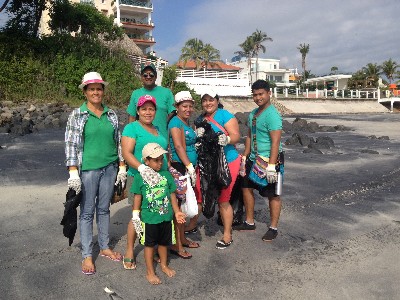Hundreds Cleanup Panama

Sunday’s national beach cleanup brought hundreds of people together in Panama to cleanup beaches, coasts and rivers in different parts of the country. Playa Community organized the group working on Playa Serena.
We met with over 60 people on Sunday morning. With an enormous amount of help from local businesses, students, staff and parents from the Coronado International School, and residents committed to cleaning up the neighborhood, we removed over 57 bags of trash from the beach, beach accesses and street! A special thanks to the Coronado Country Club administration for helping us dispose of the trash collected. A huge thank you to everyone who participated, thanks to you, our beach is spotless!
Playa Serena is not the only beach that received a makeover yesterday, according to Rita Spadafora, executive director of the National Association for the Conservation of Nature (Ancon), over 60 beaches and rivers in the country were cleaned up yesterday. Among them were: the mouth of Matías Hernández river in Costa del Este, Panama Viejo, Veracruz, Playa Serena, Playa Leona, El Palmar, San José in Punta Barco, Gorgona, Rio Mar, Corona , Otoque in the province of Panama; while in the province of Veraguas people they collected debris on beaches Queen, Torio, Malena, Santa Catalina, Bongo, Mutis, Mata Oscura, Mermejo Palo Seco, Puerto Nance, Copper River; in the province of Darien, beach cleaners cleaned up Punta Patiño.
Panama’s National Beach Cleanup is organized by ProMar, Panama Green Association, and the Audubon Society of Panama. Each year NGOs work with local groups throughout the country to organize the "Grand Cleanup". The activity is part of a global program to clean up beaches and coasts, the program has been being promoted since 1986 by The Ocean Conservancy United States.
Each year more and more people get involved with the cleanup. This year the mayors of several districts, representatives of judges, community environmental groups, schools and non-governmental organizations from different regions of the country, as well as the private sector and thousands of volunteers, took part. It is not only trash that is collected but also information.
The 2014 cleanup helped determine that the most common objects found were, 90% plastic, cigarette butts, food containers, beverage cans, plastic bags, paper bags, plastic cups and plates , plastic caps and metal caps.
Of the remaining, 4% were waste like appliances, balloons, lighters, building materials and tires. In addition, another 4% was made up of packaging materials, packing tape, packaging, other plastic bottles. 1% were items like diapers, tampons, condoms and syringes.
This information can help us inform others and create change on the items that end up contaminating our oceans, rivers and streams. These pollutants will end up being mistaken as food for fish, birds and mammals. It ends up on our plates in the food we end, in our glasses as the water we drink.
Photo Gallery for Hundreds Cleanup Panama
Trending Tags









